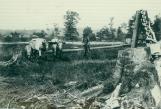1
EARLY FARMERSFrom the time the Loyalists settled in the Grimsby area in 1787, families worked together clearing and working the land to grow fruits and vegetables to feed their families and the country.
2
Anne Bridgman Describes Her Farm's History and the Original Crown Grant to Levi Lewis4 October 2008
Bridgman Farm, Winona, Ontario, Canada
 Credits:
Credits:Bridgman, Anne
Grimsby Museum Collection
3
Anne Bridgman Describes Her Farm's History and the Original Crown Grant to Levi Lewis4 October 2008
Bridgman Farm, Winona, Ontario, Canada
 Credits:
Credits:Bridgman, Anne
Grimsby Museum Collection
4
Lew Puddicombe Discusses How the Farm Was Passed Down Through Generations4 October 2008
Puddicombe Estate Farms and Winery, Winona, Ontario, Canada
 Credits:
Credits:Puddicombe, Lew
Grimsby Museum Collection
5
THE FOLLOWING GENERATIONSThe second generation faced additional challenges including the War of 1812. In addition to farming the land, the men were required to defend Upper Canada while serving in the Militia.
The third generation was very focused on the farms and this is when they began to prosper. These farmers also benefitted from the addition of the railway from Hamilton to Windsor and the steel plough invented by John Deere. In the late 1800's farming, and fruit farming in particular, was big business for local families and most men in the area were involved in the fruit business in one way or another.
6
Clearing Land for Fruit Trees on the Nelles and Kitchen Farms20th Century, Circa 1912
Nelles and Kitchen Family Farms, Grimsby, Ontario, Canada

7
Stumps Pulled From the Ground on the Nelles and Kitchen Farms20th Century, Circa 1912
Nelles and Kitchen Family Farms, Grimsby, Ontario, Canada

8
Many farms in the Niagara region operated in much the same way in the early days. On a typical fruit farm in the late 1800's there would be four buildings which included a stable building with storage, a few sheds for examining and storing fruit and the main home. Many of the farms would have an orchard of a few thousand trees. There would also be a small garden with vegetables and herbs for the family kitchen. During the course of the year, many families might hire one farmhand. This farmhand would also help in the off-season pruning and getting the farm ready for the growing season.9
Pruning Trees on the Kitchen Farm20th Century, Circa 1930
Fred Kitchen's Farm, Grimsby, Ontario, Canada

10
The farms would need to hire many others at harvest time to pick, sort, pack and transport the harvest. A typical farmer would get up about an hour before sunrise, and with the help of his children or farmhand, he would complete many farm chores before breakfast.11
Lew Puddicombe Discusses the Seasons on a Farm and the Order of the Harvests2 October 2008
Puddicombe Estate Farms and Winery, Winona, Ontario, Canada
 Credits:
Credits:Puddicombe, Lew
Grimsby Museum Collection
12
Jean Peterson Describes the Varieties of Fruit Grown on the Nelles and Kitchen Family Farms7 October 2008
Nelles and Kitchen Family Farms, Grimsby, Ontario, Canada
 Credits:
Credits:Peterson, Jean
Grimsby Museum Collection
13
Duncan Smith Explains how Farming Changes by the Seasons on his Farm8 October 2008
Smith Two Century Farm, Main Street West, Grimsby, Ontario, Canada
 Credits:
Credits:Smith, Duncan
Grimsby Museum Collection